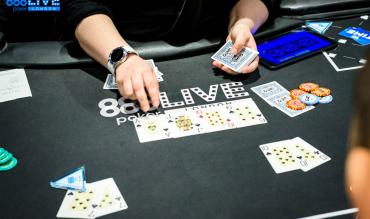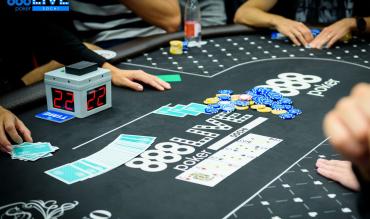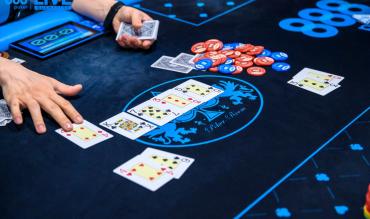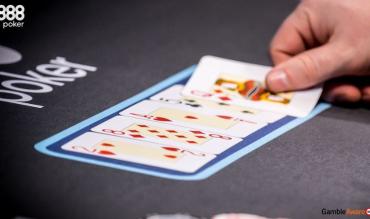One of the first things you’ll need when learning how to play poker is how the community cards work.
For those who haven’t played yet, here’s a quick breakdown:
| The community cards are dealt face-up in the middle of the table. All players can use them with their two secret hole cards to make a qualifying five-card poker hand. |
There are five community cards in total across three betting rounds.
- In the first round, three cards are dealt face-up in the middle of the table. This round is the flop.
- Two more betting rounds follow, with a single community card revealed after each.
- These final two rounds are the turn and the river.
The river is one of the most fascinating poker streets because it is the first time a poker player’s hand strength becomes final.
It is where fortunes are made, and hearts broken. It is also the focus of today’s article.
Why Is It Called the River in Poker?
Like most poker lingo, no one precisely knows the origins of the term river. One of the most popular theories claims that the term comes from throwing cheaters overboard in Mississippi riverboat games.
These games became a popular way to avoid the strict American gambling restrictions in the late 19th century.
How Does the River Work in Poker?

The river is unlike any other round in poker because it is the only street where we are guaranteed to have a winner(s).
It’s also the first time that players get to discover the final strength of their poker hand. There are no more community cards to come, so even the most promising of unimproved draws turns to dust.
Payers holding busted draws must now decide if they want to bluff or not - without the benefit of a plan B.
However, the showdown is the most significant part of the river.
At showdown, players turn their cards face up, and the player with the best hand wins the pot. This phase only happens after the final betting round has finished. We only get to see a showdown when two or more players have not folded after all betting rounds have finished.
What Does It Mean to Be Rivered in Poker?
Being rivered is one of the most annoying things in poker, and this poker term describes a player who was winning the hand until the river. It is incredibly irritating when you are all-in because you have no further opportunities to outdraw your opponent and have no more chips to bluff.

Many people take being rivered personally and can often lose their heads and go on tilt after a very unlucky river card. You might hear them referring to their opponent as a river rat when they do.
Murphy's Law tells us,‘Anything that can go wrong will go wrong.’ And since any card can fall on the river, you'll get rivered often when playing poker.
It’s crucial to remember that this is just part of the game, and the weaker hand will usually miss the river.
How to Play the River in Poker?
A poker hand is a lot like a short story. On each street, we get more and more information to consider. The plot thickens, making the story more sophisticated.
By the time we get to the river, the story has a lot of depth, which means river play can be quite tricky.
When you’re first to act, the safest way to play the river is to do the following:
- Check your middling hands
- Bet your strong hands (hoping to be called)
- Bet your weak hands as bluffs (hoping not to be called)
If your opponent bets after you check with a medium-strength hand, you can call or fold based on your read.

When you're last to act, river play is a little easier because you already know what your opponent wants. You can also check and take the hand to a showdown.
If your opponent bets into you on the river, you can call your good hands, raise your monster hands, and either fold or raise (as a bluff) with your weak hands.
Similarly, when they check, the most straightforward approach is to do the following:
- Bet when you have a strong hand
- Check when you have a medium-strength hand
- Either check or bluff when you have a weak hand
This strategy all sounds very simple when you break it down into poker combo categories. But it's far easier said than done since what a 'good hand' is can depend on a variety of factors.
Correctly deciding which hands fall into each category is a key component of good river play based on how the hand played and what you know about your opposition.
Strategy Advice for Betting the River in Poker
Most beginner guides will tell you not to bet medium-strength hands on the river. But this play is something you should do more if you find yourself playing sticky opponents who love to call and rarely bluff.

You can also bet some strong medium-strength hands to maximise your winnings against these players. They will often call with any pair they have.
For example, say a sticky opponent called your bet on a 67K flop, checked the T turn, and then checked again on a 4 river. It’s often a good idea to bet with a hand like QT or 99.
These players will likely call you with hands like A7, 88 or 45. You’ll occasionally run into a better hand when you bet your medium holdings, but you’ll make a lot of money in the long run if you pick the right opponent.
Strategy Advice for Making River Calls in Poker
One of the biggest mistakes new players make is calling the river too often or too little. Which category you fall into usually has a lot to do with your personality. But thankfully, we can use the size of the pot to understand how often you should be calling.
It’s not the actual size of the pot that is important, but more how it relates to the size of the bet we are facing.
For example –
- Our opponent bets $50 into a pot of $100
- There will now be $150 in the pot
- We will need to toss another $50 in the middle to make the call
- So, we need to pay $50 for the chance to win a $200 pot
We can afford to lose the pot three out of four times and still break even.
As a result, we should call at least one out of four times on average, or 25% of the time.
This more advanced idea is part of ‘pot odds’, which you can learn more about here.
In the meantime, we hope the river is kind to you at the tables.
See Also
Value Bet, Showdown, Flop, Turn, Bluff, Preflop, Hold’em, Omaha, Equity


